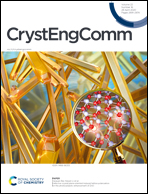Insights into OCP identification and quantification in the context of apatite biomineralization†
Abstract
Calcium phosphates (CaPs) are one of the major mineral families of wide interest in biomineralization and biomaterial development. The identification and quantification of the different CaP phases (crystalline and amorphous) remains a major challenge in both in vitro and in vivo systems. This work aims to provide critical analysis of the different analytical techniques, Raman spectroscopy, solid-state NMR spectroscopy (ssNMR) and X-ray diffraction (XRD), which are used for the discrimination of octacalcium phosphate (OCP) from hydroxyapatite (HAp). Low amounts of OCP (∼10 wt%) can be detected by Raman spectroscopy in the presence of biomimetic carbonated apatite (cHAp), provided that the ν(HPO4) contribution with weak intensity from OCP at 1008 cm−1 is observable or that the spectral decomposition of the overlapped ν1(PO4) bands from OCP and cHAp is performed. However, Raman is not suitable for quantification purposes. In contrast, the quantification of OCP in proportions down to 10 wt% is easily performed with 31P solid state NMR. Opposite to solid state NMR, Raman can be implemented under in situ conditions to monitor the time dependence of the biomineralization process without any sampling perturbation. An approach combining the advantages of in situ micro-Raman spectroscopy and the sensitivity of ex situ solid state NMR was used to monitor the formation of biomimetic carbonated apatite from an acidic aqueous solution of phosphate, carbonate and calcium ions. In relation with the progressive increase of pH, we identify the transient phases, the precursors of cHAp: it is shown that an amorphous calcium phosphate phase (ACP) is first formed and subsequently transforms into OCP that then progressively turns into cHAp. Finally, powder X-ray diffraction coupled to Rietveld refinement was found to be very powerful in quantifying very small amounts of residual OCP in cHAp (down to 2 wt%). Upon the OCP transformation into cHAp, the decrease of the relative intensity of the (100) diffraction peak of the transient OCP phase was ascribed to an alteration of its hydrated layers, related to incorporation of water molecules and/or carbonate anions with reaction time. Such carbonate uptake in the course of transformation of OCP into cHAp could explain the origin of carbonate substitutions in the final biomimetic carbonated apatite.



 Please wait while we load your content...
Please wait while we load your content...